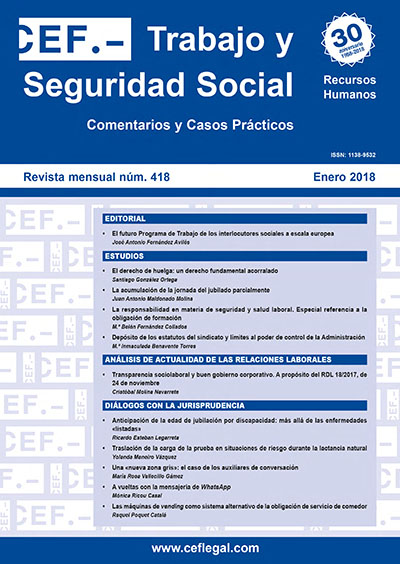Analysis of the relationship between High Performance Work Systems and corporate performance: Total Quality Management and intellectual capital
DOI:
https://doi.org/10.51302/rtss.2018.1696Keywords:
high performance work systems, intellectual capital, total quality management, business performanceAbstract
This paper analyzes the impact of High Performance Work Systems (HPWS) on business results. In order to deepen the understanding of the previous relationship and based on an extensive review of the literature, a research model has been proposed consisting of 15 hypotheses in which variables such as intellectual capital, results directly related to human resources or total quality management have been analysed. These hypotheses have been validated by a model of structural equations using the partial least squares (PLS) method. The study was carried out on a sample of 129 companies. The results confirm that HPWS positively impact business results and do so through Total Quality Management, which also has a direct impact on business results.
Downloads
References
Alfalla, R., Marín, J. A. y Medina, C. (2012). Is worker commitment necessary for achieving competitive advantage and customer satisfaction when companies use HRM and TQM practices? Universia Business Review, 36, 64-88.
Bonner, J. M. y Walker, O. C. (2004). Selecting Influential Business-to-Business Customers in New Product Development Relational Embeddedness and Knowledge Heterogeneity Considerations. Journal of Innovation Management, 21, 155-169.
Boselie, P., Dietz, G. y Boon, C. (2005). Commonalities and Contradictions in Research on Human Resource Management and Performance. Human Resource Management, 15(3), 67-94.
Chin, W. (1998). Issues and Opinion on Structural Equation Modeling. MIS Quarterly, 22(1) 7-16.
Cohen, J. (1988). Statistical Power Analysis for the Behavioral Sciences. Hillsdale, Nueva Jersey: Lawrence Erlbaum Associates.
Delaney, J. T. y Huselid, M. A. (1996). The Impact of Human Resource Management Practices on Perceptions of Organizational Performance. Academy of Management Journal, 39(4), 949-969.
Evans, J. (1992). A Report of the Total Quality Leadership Steering Committee and Working Councils. Milwaukee: Procter & Gamble.
Falk, R. y Miller, N. (1992). A Primer for Soft Modeling. Akron, Ohio: University of Akron Press.
Fornell, C. y Larcker, D. F. (1981). Evaluating Structual Equations Models with Unobservable Variables and Measurement Error. Journal of Marketing Research, 18, 39-50.
Fuentes, M. M. y Hurtado, N. E. (2002). Variables críticas en la medición del desempeño en empresas con implantación de la gestión de la calidad total. Investigaciones Europeas de Dirección y Economía de la Empresa, 8(2), 87-102.
Grant, R. M. (1991). The resource-Based Theory of Competitive Advantage: Implications for Strategy Formulation. California Management Review, 33(3), 114-134.
Guimaraes, T. (1996). TQM’s impact on Employee Attitudes. The TQM Magazine, 8(1), 20-25.
Hair, J. F., Hult, G. T., Ringle, C. y Sarstedt, M. (2014). A Primer on Partial Least Squares Structural Equation Modeling (PLS-SEM). Sage Publications.
Hitt, M. A., Bierman, L., Shimizu, K. y Kochhar, R. (2001). Direct and Moderating Effects of Human Capital on Strategy and Performance in Professional Service Firms: A Resource-Based Perspective. Academy of Management Journal, 44(1), 13-28.
Huselid, M. A. (1995). The Impact of Human Resource Management Practices on Turnover, Productivity and Corporate Financial Performance. Academy of Management Journal, 38(3), 635-672.
Kor, Y. Y. y Leblebici, H. (2005). How do interdependencies among human-capital deployment, development, and diversification strategies affect firms’ financial performance? Strategic Management Journal, 26(10), 967-985.
Lee, C. y Nan, C. (2012). The Impact of Human Resource Configurations on Intellectual Capital in the Australian Biotechnology. Journal of International Management Studies, 7(1), 201-207.
Lee, J. y Peccei, R. (2006). Perceived Organizational Support and Affective Commitment: The Mediating Role of Organization-Based Self-Esteem in the Context of Job Insecurity. Journal of Organizational Behavior, 28(6), 661-685.
Marín, L. M. (2013). Gestión de la calidad total e indicadores no financieros: reflejo del valor de la certificación ISO 9001. Revista Europea de Dirección y Economía de la Empresa, 22(2), 97-106.
Nahapiet, J. y Ghoshal, S. (1998). Social Capital, Intellectual Capital and the Organizational Advantage. Academy of Management Review, 23(2), 242-266.
Nunnally, J. C. (1978). Phychometric Theory. New York: McGraw-Hill.
Ordóñez de Pablos, P. (2004). El capital estructural organizativo como fuente de competitividad empresarial: un estudio de indicadores. Economía industrial, 357, 131-140.
Peteraf, M. A. (1993). The Cornerstones of Competitive Advantage: A Resource-Based View. Strategic Management Journal, 14(3), 179-191.
Powell, T. C. (1995). Total Quality Management as Competitive Advantage: A Review and Empirical Study. Strategic Management Journal, 16(1), 15-37.
Subramaniam, M. y Youndt M. A. (2005). The Influence of Intellectual Capital on the Types of Innovative Capabilities. Academy of Management Journal, 48, 450-463.
Teo, T. S., Srivastava, S. C. y Jiang, L. (2008). Trust and Electronic Govemment Success: An Empirical Study. Journal of Management Information Systems, 25(3), 99-132.
Wright, P. M., McMahan, G. C. y McWilliams, A. (1994). Human Resources and Sustained Competitive Advantage: A Resource-Based Perspective. International Journal of Human Resource Management, 5(2), 301-326.
Yang, C. C. (2006). The Impact of Human Resource Management Practices on the Implementation of Total Quality Management: An Empirical Study. The TQM Magazine, 18(2), 162-173.
Youndt, M. A., Subramaniam, M. y Snell, S. A. (2004). Intellectual Capital Profiles: An Examination of Investments and Returns. Journal of Management Studies, 41(2), 335-361.
Youndt, M. A. y Snell, S. A. (2004). Human Resource Configurations, Intellectual Capital and Organizational Performance. Journal of Management Issues, 16(3), 337-360.
Youndt, M., Snell, S., Dean, J. y Lepak, D. (1996). Human Resource Management, Manufacturing Strategy and Firm Performance. Academy of Management Journal, 39(4), 836-866.
Zhang, M., Di Fan, D. y Zhu, C. J. (2014). High-Performance Work Systems, Corporate Social Performance and Employee Outcomes: Exploring the Missing Links. Journal of Business Ethics, 120(3), 423-435.


















